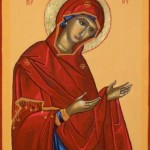
A member of the congregation at Colerne parish church has put her artistic gifts to good use by creating a series of icons for the church's Lady Chapel.
he three images of Christ Pantocrater (ruler of all), Saint Mary Theotokos (the God-bearer) and St John the Baptist, the Prodromos (forerunner) have been written (icons are traditionally described as written, not drawn) by Annette Barker for the benefit of members of the congregation and visitors alike.
Annette provides the following background on iconography and its use in churches.
The word icon is from the Greek term eikona, meaning image, likeness or portrait. As such it can, and does, apply to any image, but we are referring here to the Christian icon or holy icon. It is a tradition commonly associated with the Eastern Orthodox Church.
However, it is one that was shared with Christendom of Western Europe from the first centuries of the Church until around the fourteenth century when naturalism began to predominate in Western art. With differing iconographic styles all portraying strange perspectives, unfamiliar proportions and symbolism of colours and design, icons are said to play an increasing part in the spiritual life of non-Orthodox Christians today.
An icon must be blessed and consecrated by a priest before its use in worship. Icons themselves are not worshipped but rather venerated as windows, doorways or gateways leading us through into the presence of the holy person depicted. Sitting or standing contemplating the image, we are invited to enter personally into the mystery that is set before us.
The process of painting (or more correctly writing) an icon can be quite lengthy depending on size and the images complexity.
The three created for Colerne are roughly A4 in size and each took between one and four weeks of painting (using ground mineral pigments with egg tempera) and gilding to complete. However, before this, there is initial preparation of each board to obtain the required surface, achieved by applying up to 13 coats of gesso, and afterwards there is a drying period for about 3 months before the final coat of shellac varnish is applied to give some protection to the icons surface.